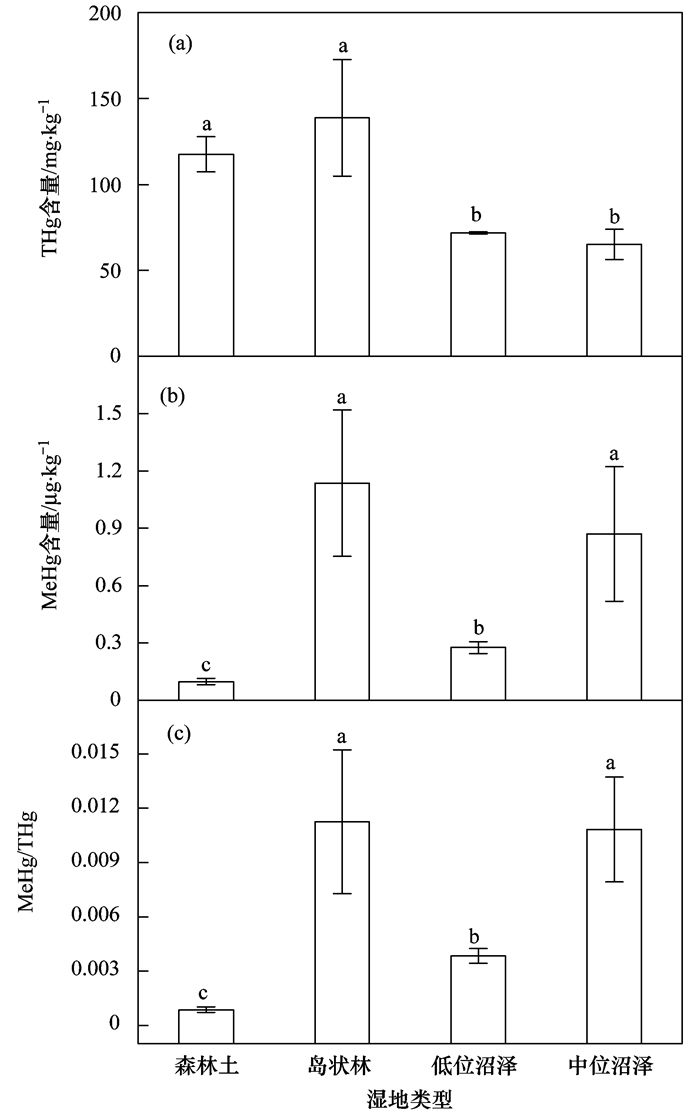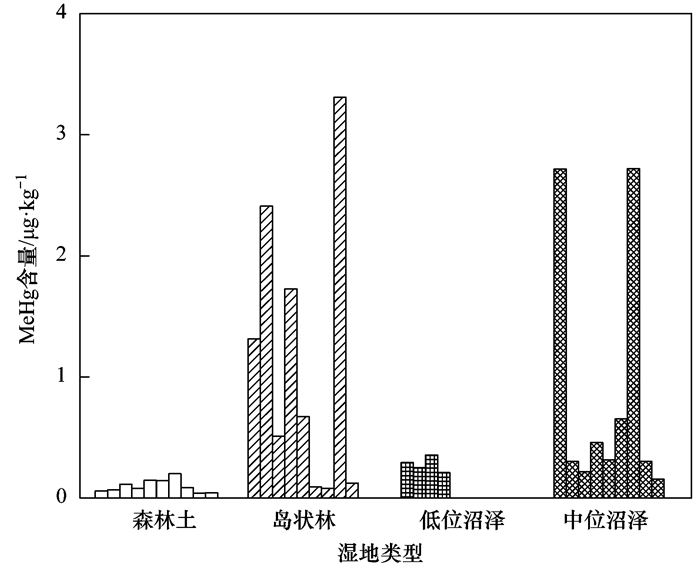2. 中国科学院生态环境研究中心, 北京 100085;
3. 中国林业科学研究院湿地研究所, 北京 100091
2. Research Center for Eco-Environmental Sciences, Chinese Academy of Sciences, Beijing 100085, China;
3. Institute of Wetland Research, Chinese Academy of Forestry, Beijing 100091, China
汞(Hg)是唯一能够在自然条件下以液态形式存在的剧毒重金属污染物[1~4], 常温下蒸发的Hg蒸气可以伴随着大气循环进行远距离的传输[5], 在全球Hg的生物地球化学循环过程中起到了重要作用[6].大气中Hg0一方面继续随着大气环流进行长距离的传播, 另一方面通过被植物吸收或氧化后以干湿沉降的方式返回陆地地表, 使生态系统受到污染[6]. Hg主要以无机Hg的形式存在于自然环境中, 通过甲基化过程转化成MeHg[7]. MeHg具有生物富集和食物链放大的作用, 对特定人群构成威胁[8, 9].非生物因素(pH、有机质等)和生物因素是影响Hg甲基化过程的重要因素[10~16]. Hg发生甲基化的甲基供体是厌氧微生物产生的甲基钴胺素[17], 所以甲基化反应常发生在厌氧环境中, 好氧环境则不利于微生物的甲基化[18~20].这些厌氧微生物的分布特征以及数量直接决定着MeHg在湿地生态系统中的富集程度[21].尽管Hg甲基化反应可以在很多环境发生, 但是沉积物和土壤是其主要场所[22~24].前人对MeHg的研究主要集中在森林土壤[25, 26]、水稻土壤[27]、水体环境[28]以及沉积物[29], 对沼泽中MeHg积累的报道相对较少.因此, 本文以大兴安岭不同湿地类型(中位沼泽、低位沼泽、岛状林、森林土)为研究对象, 分析4种湿地类型土壤MeHg含量, 通过揭示湿地环境, 尤其是沼泽湿地, MeHg的分布特征及其影响因素, 以期为湿地中Hg污染防控提供重要数据支持.
1 材料与方法 1.1 研究区域样品采集于南瓮河国家自然保护区内, 该区是大兴安岭地区湿地面积最大、资源最集中的地区.研究区域的地理位置为东经125°08′11″~125°16′38″, 北纬51°8′15″~51°10′17″, 海拔最高为460 m, 最低为420 m.湿地类型主要有森林湿地、草丛湿地、灌丛湿地、湿地岛状林、冰间湖湿地和湖泊湿地[30].湿地地形走势是西北高东南低, 南瓮河是该湿地水分的主要来源[31].
1.2 样品采集和处理2016年8月, 在大兴安岭南瓮河湿地分别采集了低位沼泽(4份样品)、中位沼泽(9份样品)、岛状林(9份样品)和森林土(10份样品)这4个不同湿地的土壤样品.用样品袋密封之后低温运回实验室, 除去土壤样品中混有的植物枯枝落叶和石头等杂质, 自然风干.
1.3 土壤基本理化性质分析土壤样品理化性质的测定参照《土壤农化分析》[32]中的方法.土壤pH采用pH计(Fe20-K)测定, 水:土=2.5:1;土壤含水率采用烘干法测定; 土壤有机质采用重铬酸钾-比色法测定; 铵态氮含量采用连续流动分析仪(AA3, 德国SEAL公司)测定, 用1 mol·L-1的KCl(国药, 优级纯)溶液浸提(液土比5:1);总碳和总氮采用元素分析仪(Vario TOC, 德国Elementar公司)测定.
1.4 土壤THg与MeHg测定THg测定:采集的土样自然风干、研磨, 过100目筛.称取0.1 g土壤样品于镍舟之中, 每个样品3个重复, 放入测汞仪(Milestone DMA-80 Direct Mercury Analyzer)进行THg分析.
MeHg测定:称取0.5 g左右过100目的土壤样品于15 mL的离心管中, 在通风橱中加入2 mL的消解液(KOH-甲醇)、涡旋, 使土壤样品和消解液充分混匀; 将离心管倾斜放在摇床上, 70℃、230 r·min-1振荡4 h, 消解过程中取出涡旋一次; 消解结束后, 冷却至室温, 用超纯水定容至12 mL; 4 000 r·min-1离心20 min.取50 μL上清液与缓冲液、乙基化试剂混合之后用全自动甲基汞仪(Model Ⅲ, Brooks Rand Labs)测定, 检出限为0.001 ng·mL-1.
实验过程采用平行实验、标准物质和空白对照进行质量控制, THg的标准物质为GBW07405(GSS-5), 参考含量为(0.29±0.03) μg·g-1, 测定值为(0.30±0.12) μg·g-1, MeHg的标准物质为ERM-CC580, 参考含量为(75±4) μg·kg-1, 测定值为(73±3) μg·kg-1. THg和MeHg的标准物质的加标回收率分别为100.5%~108.43%和94.5%~101.9%, 实验中空白值为样品测定值的1%~3%, 可忽略不计.
1.5 数据处理采用Excel 2010对数据进行汇总; SPSS 19.0软件对数据进行相关分析、单因素方差分析; Origin 9.0软件绘图.
2 结果与分析 2.1 各湿地类型土壤基本性质由表 1可以看出, 森林土的含水率低于另外3种类型, 但其有机质含量高于岛状林和中位沼泽.低位沼泽土壤的含水率、总氮、铵态氮和总碳均高于中位沼泽. 4种湿地土壤均为酸性, 其中中位沼泽地区的pH值变化范围明显高于其他3种地形, 且其有机质含量最低.
|
|
表 1 不同湿地类型土壤理化指标的变化范围1) Table 1 Variation of the physicochemical soil index of different wetland types |
2.2 各湿地类型土壤中THg和MeHg含量
表 2为4种湿地类型中THg、MeHg含量和甲基化率(MeHg/THg)的平均值.可见, 各类型土壤中THg的平均含量均高于黑龙江省土壤环境背景值37 ng·g-1 [33].森林土和岛状林土壤中THg含量显著高于中位和低位沼泽(P<0.05)[图 1(a)]; 森林土中MeHg含量显著低于岛状林、低位和中位沼泽(P<0.05)[图 1(b)]; 森林土的MeHg/THg与岛状林、低位和中位沼泽存在显著性差异(P<0.05)[图 1(c)]. MeHg与THg含量在4种湿地类型土壤中变化趋势不一致.
|
|
表 2 4种湿地类型土壤中THg、MeHg含量和MeHg/THg值1) Table 2 Contents of THg, MeHg, and MeHg/THg in the soil of four wetland types |

|
图中误差线为标准偏差, 其上方不同小写字母代表不同湿地类型之间的差异性显著(P<0.05) 图 1 不同湿地类型下THg、MeHg含量和甲基化率 Fig. 1 Total Hg content, MeHg content and methylation rate of different wetland types |
各类型湿地土壤中MeHg含量的变异性特征如图 2所示.总体看来, 森林土中MeHg的含量低于岛状林、低位和中位沼泽.在森林土和低位沼泽区, 不同取样点之间MeHg含量的波动较小, 而岛状林和中位沼泽地区, 不同取样点之间MeHg含量的波动较大.其中, 岛状林最高浓度为3.31 μg·kg-1, 是最低浓度的41倍; 中位沼泽最高浓度为2.72 μg·kg-1, 是最低浓度的17倍.

|
图 2 不同湿地类型中MeHg含量变异性特征 Fig. 2 Variation of MeHg of different wetland types |
表 3为各类型湿地土壤样品理化指标与MeHg含量、MeHg/THg的Spearman相关性分析. MeHg含量与土壤pH呈显著正相关(P<0.05); MeHg/THg与土壤pH呈显著负相关(P<0.01), 与土壤有机质和THg含量呈显著正相关(P<0.05).不同湿地类型影响MeHg形成的土壤理化因子不同(图 3), 在中位沼泽地区, MeHg含量与土壤含水率(P<0.01)、有机质(P<0.05)、总碳(P<0.05)、THg含量(P<0.01)具有线性关系; 在岛状林地区, MeHg含量则与土壤pH及NH4+-N含量具有线性关系.
|
|
表 3 湿地土壤中MeHg含量、甲基化率与理化指标的相关分析1) Table 3 Correlation analysis of the MeHg content, methylation rate, and physicochemical indexes of wetland soils |

|
图 3 不同湿地土壤MeHg含量与理化指标相关分析 Fig. 3 Relationship between the content of MeHg and soil properties of different wetland soils |
有研究报道, 美国Louisiana湖泊2个不同水体沉积物中甲基化率分别为0.27%和0.5%[34], 加拿大Kejimkujik公园湿地的甲基化率达到了3.2%[35], 美国North Dakota的Lostwood野生动物保护区湖泊湿地沉积物中甲基化率为2.2%[36], 大沽河排污河道水体沉积物中甲基化率为2.4%[37].而在大兴安岭南瓮河区域4种湿地类型中, 低位沼泽的甲基化率为0.38%、中位沼泽的甲基化率为1.08%、岛状林的甲基化率为1.12%、森林土的甲基化率为0.09%.总体来看, 岛状林、中位沼泽、低位沼泽和森林土的甲基化率均低于国外湿地中的甲基化率.本课题组对若尔盖湿地土样中的MeHg也进行了测定, 发现在若尔盖湿地地区甲基化率为0.174%~3.253%, 贵州铜仁和万山水稻土的甲基化率分别为0.06%~0.17%和0.02%~0.23%(未发表数据).可见, 南瓮河区域4种湿地类型的甲基化率高于贵州铜仁、万山水稻土的甲基化率, 和若尔盖湿地的甲基化率相近.水稻土中甲基化率低于沼泽和湿地, 可能是因为水稻土存在干湿交替的现象, 淹水期间土壤中MeHg含量增加, 当稻田处于干旱时, 甲基化产物主要是二甲基汞, 导致MeHg的积累降低[38]; 湿地土壤长年浸泡在水中, 形成了稳定的厌氧环境, 使Hg甲基化反应维持在一个相对平稳的状态, 因此, MeHg含量不断积累.湿地是森林中MeHg的重要来源[39], 通过对湿地中MeHg的研究, 可以采取一些措施减少MeHg的暴露, 减少对人类的危害.
3.2 影响湿地土壤MeHg含量的主要因素本研究探讨了影响大兴安岭南瓮河4种湿地类型中MeHg含量的分布特点及其影响因素.森林土有机质含量高于另外3种地形, 但其MeHg的含量最低, 可能是由于从森林演变成沼泽的过程中, 植物凋落物中有机质的归还量逐渐减少[40], 导致土壤中有机质的含量降低; 有机质对Hg的甲基化具有双重作用, 一方面可以为微生物生存提供充足的营养物质, 另一方面能与Hg紧密结合, 降低无机Hg对甲基化微生物的生物有效性[19, 41, 42], 进而影响MeHg的含量.森林土和岛状林湿地中的碳含量明显高于低位沼泽和中位沼泽, 是因为森林生态系统是陆地生态系统最大的碳库[43].岛状林湿地土壤表面和孔隙中的水含有大量的可溶性碳, 为甲基化微生物进行代谢活动提供了充足的营养物质[40].岛状林周围沼泽中积累的MeHg随着地下水和地表水的流动转移到土壤中, 从而导致岛状林土壤中MeHg含量较高. pH与MeHg含量呈显著正相关(P<0.05), 有研究发现, pH会影响Hg在土壤中的溶解度, 也可以间接影响Hg在土壤中的存在形态[40], 酸性土壤会增加Hg的甲基化程度, 但当pH<4时, 易受到腐殖酸的影响, Hg的活性降低, 从而降低Hg的甲基化程度[44].本研究4种类型土壤pH的变化范围是4.78~6.77, 属于酸性土壤, 在一定程度上促进MeHg的形成.除了非生物因素之外, 微生物作用引起的Hg甲基化也逐渐受到人们的广泛关注[45], 厌氧沉积物中主要的甲基化微生物是硫酸盐还原菌, 随后又相继发现产甲烷菌和铁还原菌也具有甲基化的能力[11, 12, 46, 47].在大兴安岭4种湿地类型中, 沼泽地区的MeHg含量明显高于未沼泽(森林土)地区, 说明沼泽地区形成的厌氧环境有利于甲基化微生物的代谢活动, 长期的沼泽环境导致其较高的MeHg累积.
4 结论(1) 大兴安岭湿地中, 森林土[(117.57±32.44) mg·kg-1]、岛状林[(138.76±101.97) mg·kg-1]、低位沼泽[(71.8±1.42) mg·kg-1]、中位沼泽[(65.11±26.69) mg·kg-1]中THg的含量均高于黑龙江省土壤环境背景值, 表明该区域湿地土壤受到Hg的污染.
(2) 大兴安岭4种湿地类型中, 土壤pH是影响MeHg含量的主要因素; 森林土中MeHg的含量低于沼泽土壤; 中位沼泽地区, 土壤含水率、总碳、有机质、THg含量与MeHg含量具有线性关系, 说明这些因子也能在一定程度上影响MeHg的积累.
(3) 中位沼泽中MeHg的含量[(0.87±1.06) μg·kg-1]高于低位沼泽[(0.28±0.06) μg·kg-1], 表明沼泽形成的时间越长, 其环境越有利于Hg的甲基化.
| [1] |
冯新斌, 尹润生, 俞奔, 等. 汞同位素地球化学概述[J]. 地学前缘, 2015, 22(5): 124-135. Feng X B, Yin R S, Yu B, et al. A review of Hg isotope geochemistry[J]. Earth Science Frontiers, 2015, 22(5): 124-135. |
| [2] | Mahaffey K, Rice G. Mercury study report to Congress. Volume 4. An assessment of exposure to mercury in the United States[R]. Environmental Protection Agency, Research Triangle Park, NC (United States). Office of Air Quality Planning and Standards, 1997. https://www.epa.gov/mercury/mercury-study-report-congress |
| [3] |
阴永光, 李雁宾, 蔡勇, 等. 汞的环境光化学[J]. 环境化学, 2011, 30(1): 84-91. Yin Y G, Li Y B, Cai Y, et al. Environmental photo-chemistry of mercury[J]. Environmental Chemistry, 2011, 30(1): 84-91. |
| [4] |
李玉锋, 赵甲亭, 李云云, 等. 同步辐射技术研究汞的环境健康效应与生态毒理[J]. 中国科学:化学, 2015, 45(6): 597-613. Li Y F, Zhao J T, Li Y Y, et al. Studies on the environmental health effects and ecotoxicology of mercury by synchrotron radiation-based techniques[J]. Scientia Sinica Chimica, 2015, 45(6): 597-613. |
| [5] | Johansson K, Bergbäck B, Tyler G. Impact of atmospheric long range transport of lead, mercury and cadmium on the Swedish forest environment[J]. Water, Air and Soil Pollution:Focus, 2001, 1(3-4): 279-297. |
| [6] | Lindqvist O, Johansson K, Bringmark L, et al. Mercury in the Swedish environment-recent research on causes, consequences and corrective methods[J]. Water, Air, and Soil Pollution, 1991, 55(1-2): ⅹⅰ-261. |
| [7] | Lawson N M, Mason R P, Laporte J M. The fate and transport of mercury, methylmercury, and other trace metals in Chesapeake Bay tributaries[J]. Water Research, 2001, 35(2): 501-515. DOI:10.1016/S0043-1354(00)00267-0 |
| [8] | Harada M. Minamata disease:methylmercury poisoning in Japan caused by environmental pollution[J]. Critical Reviews in Toxicology, 1995, 25(1): 1-24. DOI:10.3109/10408449509089885 |
| [9] | Clarkson T W, Magos L, Myers G J. The toxicology of mercury-current exposures and clinical manifestations[J]. The New England Journal of Medicine, 2003, 349(18): 1731-1737. DOI:10.1056/NEJMra022471 |
| [10] | Celo V, Lean D R S, Scott S L. Abiotic methylation of mercury in the aquatic environment[J]. Science of the Total Environment, 2006, 368(1): 126-137. DOI:10.1016/j.scitotenv.2005.09.043 |
| [11] | Compeau G C, Bartha R. Sulfate-reducing bacteria:principal methylators of mercury in anoxic estuarine sediment[J]. Applied and Environmental Microbiology, 1985, 50(2): 498-502. |
| [12] | Kerin E J, Gilmour C C, Roden E, et al. Mercury methylation by dissimilatory iron-reducing bacteria[J]. Applied and Environmental Microbiology, 2006, 72(12): 7919-7921. DOI:10.1128/AEM.01602-06 |
| [13] | Pan-Hou H S, Hosono M, Imura N. Plasmid-controlled mercury biotransformation by clostridium cochlearium T-2[J]. Applied and Environmental Microbiology, 1980, 40(6): 1007-1011. |
| [14] | Vonk J W, Sijpesteijn A K. Studies on the methylation of mercuric chloride by pure cultures of bacteria and fungi[J]. Antonie van Leeuwenhoek, 1973, 39(1): 505-513. DOI:10.1007/BF02578894 |
| [15] | Weber J H. Review of possible paths for abiotic methylation of mercury(Ⅱ) in the aquatic environment[J]. Chemosphere, 1993, 26(11): 2063-2077. DOI:10.1016/0045-6535(93)90032-Z |
| [16] | Wood J M. Biological cycles for toxic elements in the environment[J]. Science, 1974, 183(4129): 1049-1052. DOI:10.1126/science.183.4129.1049 |
| [17] | Raposo J C, Ozamiz G, Etxebarria N, et al. Mercury biomethylation assessment in the estuary of Bilbao (North of Spain)[J]. Environmental Pollution, 2008, 156(2): 482-488. DOI:10.1016/j.envpol.2008.01.017 |
| [18] | Monperrus M, Tessier E, Amouroux D, et al. Mercury methylation, demethylation and reduction rates in coastal and marine surface waters of the Mediterranean Sea[J]. Marine Chemistry, 2007, 107(1): 49-63. DOI:10.1016/j.marchem.2007.01.018 |
| [19] | Ullrich S M, Tanton T W, Abdrashitova S A. Mercury in the aquatic environment:a review of factors affecting methylation[J]. Critical Reviews in Environmental Science and Technology, 2001, 31(3): 241-293. DOI:10.1080/20016491089226 |
| [20] |
刘金铃, 丁振华. 汞的甲基化研究进展[J]. 地球与环境, 2007, 35(3): 215-222. Liu J L, Ding Z H. Progress in research on mercury methylation in environment[J]. Earth and Environment, 2007, 35(3): 215-222. |
| [21] |
梁小兵. 汞甲基化细菌研究进展[J]. 生态学杂志, 2013, 32(3): 755-761. Liang X B. Mercury methylation bacteria and methyl mercury producing:a review[J]. Chinese Journal of Ecology, 2013, 32(3): 755-761. |
| [22] | Gilmour C C, Henry E A, Mitchell R. Sulfate stimulation of mercury methylation in freshwater sediments[J]. Environmental Science & Technology, 1992, 26(11): 2281-2287. |
| [23] | Guimarães J R D, Meili M, Hylander L D, et al. Mercury net methylation in five tropical flood plain regions of Brazil:high in the root zone of floating macrophyte mats but low in surface sediments and flooded soils[J]. Science of the Total Environment, 2000, 261(1-3): 99-107. DOI:10.1016/S0048-9697(00)00628-8 |
| [24] |
丁振华, 王文华, 庄敏. 汞的界面地球化学研究进展[J]. 海洋科学, 2005, 29(10): 54-57, 64. Ding Z H, Wang W H, Zhuang M. Progress of interfacial geochemistry of mercury[J]. Marine Science, 2005, 29(10): 54-57, 64. DOI:10.3969/j.issn.1000-3096.2005.10.013 |
| [25] | Eklöf K, Bishop K, Bertilsson S, et al. Formation of mercury methylation hotspots as a consequence of forestry operations[J]. Science of the Total Environment, 2018, 613-614: 1069-1078. DOI:10.1016/j.scitotenv.2017.09.151 |
| [26] | Braaten H F V, de Wit H A. Effects of disturbance and vegetation type on total and methylmercury in boreal peatland and forest soils[J]. Environmental Pollution, 2016, 218: 140-149. DOI:10.1016/j.envpol.2016.08.029 |
| [27] |
王欣悦, 唐振亚, 张成, 等. 长期不同耕作方式下紫色水稻土和上覆水中汞及甲基汞的分布特征[J]. 环境科学, 2016, 37(3): 910-916. Wang X Y, Tang Z Y, Zhang C, et al. Effects of long-term different tillage methods on mercury and methylmercury contents in purple paddy soil and overlying water[J]. Environmental Science, 2016, 37(3): 910-916. |
| [28] | Eckley C S, Hintelmann H. Determination of mercury methylation potentials in the water column of lakes across Canada[J]. Science of the Total Environment, 2006, 368(1): 111-125. DOI:10.1016/j.scitotenv.2005.09.042 |
| [29] | Liem-Nguyen V, Jonsson S, Skyllberg U, et al. Effects of nutrient loading and mercury chemical speciation on the formation and degradation of methylmercury in estuarine sediment[J]. Environmental Science & Technology, 2016, 50(13): 6983-6990. |
| [30] |
晏鸣霄, 夏振清, 王攀婷, 等. 南瓮河湿地保护区土壤有机碳、含水率和pH的变化分布[J]. 森林工程, 2015, 31(4): 22-25. Yan M X, Xia Z Q, Wang P T, et al. Distribution of the variations of the soil organic carbon, moisture content, and pH in Nanweng river wetland reserve[J]. Forest Engineering, 2015, 31(4): 22-25. DOI:10.3969/j.issn.1001-005X.2015.04.006 |
| [31] |
刘玉臣, 崔克城, 陈佰利. 大兴安岭南瓮河森林湿地现状及保护措施[J]. 林业科技, 2002, 27(3): 21-22. Liu Y C, Cui K C, Chen B L. Present condition and protection measures of forest wetland of Nanweng River, Daxing'anling[J]. Forestry Science & Technology, 2002, 27(3): 21-22. |
| [32] | 鲍士旦. 土壤农化分析[M]. 第三版. 北京: 中国农业出版社, 2000. |
| [33] | 国家环境保护局, 中国环境监测总站. 中国土壤元素背景值[M]. 北京: 中国环境科学出版社, 1990: 354-356. |
| [34] | DeLaune R D, Jugsujinda A, Devai I, et al. Relationship of sediment redox conditions to methyl mercury in surface sediment of Louisiana Lakes[J]. Journal of Environmental Science and Health, Part A, 2004, 39(8): 1925-1933. DOI:10.1081/ESE-120039365 |
| [35] | O'Driscoll N J, Beauchamp S, Siciliano S D, et al. Continuous analysis of dissolved gaseous mercury (DGM) and mercury flux in two freshwater lakes in Kejimkujik Park, Nova Scotia:evaluating mercury flux models with quantitative data[J]. Environmental Science & Technology, 2003, 37(10): 2226-2235. |
| [36] | Sando S K, Krabbenhoft D, Johnson K M, et al. Mercury and methylmercury in water and bottom sediments of wetlands at Lostwood National Wildlife Refuge, North Dakota, 2003-04[R]. Reston, VA: US Geological Survey, 2007. http://agris.fao.org/agris-search/search.do?recordID=US201300126604 |
| [37] | Shi J B, Liang L N, Jiang G B, et al. The speciation and bioavailability of mercury in sediments of Haihe River, China[J]. Environment International, 2005, 31(3): 357-365. DOI:10.1016/j.envint.2004.08.008 |
| [38] |
张成, 宋丽, 王定勇, 等. 三峡库区消落带甲基汞变化特征的模拟[J]. 中国环境科学, 2014, 34(2): 499-504. Zhang C, Song L, Wang D Y, et al. Simulation on the variation characteristics of methylmercury of the water-level-fluctuating zone in the Three Gorges Area[J]. China Environmental Science, 2014, 34(2): 499-504. |
| [39] | Louis V L S, Rudd J W M, Kelly C A, et al. Importance of wetlands as sources of methyl mercury to boreal forest ecosystems[J]. Canadian Journal of Fisheries and Aquatic Sciences, 1994, 51(5): 1065-1076. DOI:10.1139/f94-106 |
| [40] |
郑冬梅, 杨继松, 李航, 等. 辽河口不同类型湿地土壤汞、甲基汞含量及其影响因素[J]. 生态学杂志, 2017, 36(4): 1067-1071. Zheng D M, Yang J S, Li H, et al. Mercury and methylmercury concentrations and their influencing factors in soils of different types of wetlands of Liaohe Estuary[J]. Chinese Journal of Ecology, 2017, 36(4): 1067-1071. |
| [41] | Da Cunha-Santino M B, Júnior I B. Humic substance mineralization in a tropical oxbow lake (São Paulo, Brazil)[J]. Hydrobiologia, 2002, 468(1-3): 33-43. |
| [42] |
彭倩, 朱慧可, 钟寰, 等. 腐殖酸对汞污染稻田中甲基汞行为的影响[J]. 生态与农村环境学报, 2015, 31(5): 748-752. Peng Q, Zhu H K, Zhong H, et al. Effects of humic acid on behaviors of methylmercury in Hg-contaminated paddy soil[J]. Journal of Ecology and Rural Environment, 2015, 31(5): 748-752. |
| [43] |
徐耀粘, 江明喜. 森林碳库特征及驱动因子分析研究进展[J]. 生态学报, 2015, 35(3): 926-933. Xu Y Z, Jiang M X. Forest carbon pool characteristics and advances in the researches of carbon storage and related factors[J]. Acta Ecologica Sinica, 2015, 35(3): 926-933. |
| [44] | Liu X, Ma A Z, Zhuang G Q, et al. Diversity of microbial communities potentially involved in mercury methylation in rice paddies surrounding typical mercury mining areas in China[J]. MicrobiologyOpen, 2018. DOI:10.1002/mbo3.577 |
| [45] |
胡海燕, 冯新斌, 曾永平, 等. 汞的微生物甲基化研究进展[J]. 生态学杂志, 2011, 30(5): 874-882. Hu H Y, Feng X B, Zeng Y P, et al. Progress in research on microbial methylation of mercury[J]. Chinese Journal of Ecology, 2011, 30(5): 874-882. |
| [46] | Fleming E J, Mack E E, Green P G, et al. Mercury methylation from unexpected sources:molybdate-inhibited freshwater sediments and an iron-reducing bacterium[J]. Applied and Environmental Microbiology, 2006, 72(1): 457-464. DOI:10.1128/AEM.72.1.457-464.2006 |
| [47] | Jensen S, Jernelöv A. Biological methylation of mercury in aquatic organisms[J]. Nature, 1969, 223(5207): 753-754. DOI:10.1038/223753a0 |
 2018, Vol. 39
2018, Vol. 39


